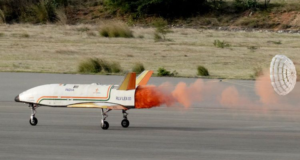 New Delhi: In a remarkable achievement, the Indian Space Research Organisation (ISRO) has successfully completed a hat-trick of safe landings for its uncrewed, autonomous winged reusable launch vehicle, Pushpak. This milestone was reached during an experiment on Sunday.
New Delhi: In a remarkable achievement, the Indian Space Research Organisation (ISRO) has successfully completed a hat-trick of safe landings for its uncrewed, autonomous winged reusable launch vehicle, Pushpak. This milestone was reached during an experiment on Sunday.
In an official statement, ISRO announced, “We are proud to have achieved a third consecutive success in the Reusable Launch Vehicle (RLV) Landing Experiment (LEX) on Sunday. The third and final test in the series, LEX-03, was conducted at 07:10 IST at the Aeronautical Test Range (ATR) in Chitradurga, Karnataka.”
This accomplishment marks a significant leap forward for India’s space ambitions, positioning ISRO ahead of other agencies that are still in the early stages of developing reusable launch technology.
Based on the success of this test, ISRO plans to develop a larger vehicle for orbital tests, which will undergo landing experiments before being launched into space and returning to Earth like a space plane.
The success of RLV LEX-03 follows the achievements of the previous missions, LEX-01 and LEX-02, and demonstrated the autonomous landing capability of the RLV under more challenging conditions. The recent test involved a cross-range of 500 meters, compared to 150 meters for LEX-02, and more severe wind conditions.
For the experiment, the winged vehicle Pushpak was released from an Indian Air Force Chinook Helicopter at an altitude of 4.5 kilometers, 4.5 kilometers away from the runway.
Pushpak autonomously executed cross-range correction maneuvers, approached the runway, and performed a precise horizontal landing at the runway centerline. The vehicle’s aerodynamic configuration, characterized by a low lift-to-drag ratio, resulted in a landing velocity exceeding 320 km/h, compared to 260 km/h for commercial aircraft and 280 km/h for typical fighter aircraft.
After touchdown, the vehicle’s speed was reduced to nearly 100 km/h using a brake parachute, followed by landing gear brakes for complete deceleration and stop on the runway.
During this ground roll phase, Pushpak utilized its rudder and nose wheel steering system to maintain a stable and precise path along the runway, ISRO’s statement added.



